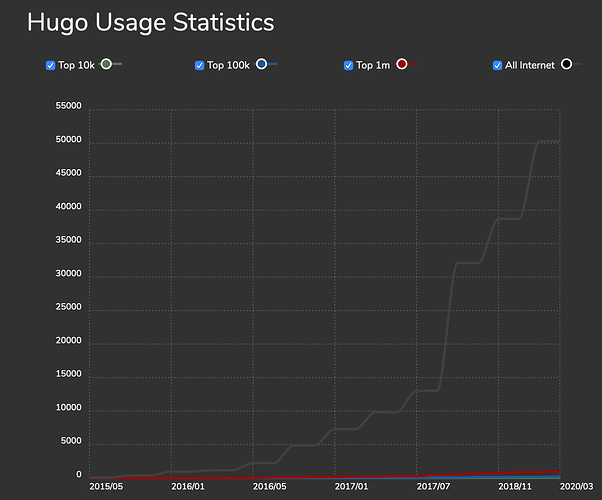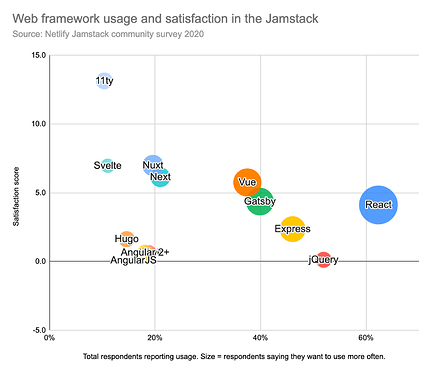And if you check the all internet box:
That seems too small to be visually relevant.
The whole trend or what?
Actually, I couldn’t see the line before. I think it is the dark theme, I thought it was just flat lines, which isn’t helpful to understand what’s happening. As it is, on the dark theme I’m not sure what is happening. Is the lighter grey the “all” line?
Hi guys!
I came to Hugo from home made HTML -> … -> WordPress -> Drupal -> Middleman, and never ever looked back. Throughout the years I was able to convince many companies to use Hugo exclusively for all web their (non-highly dynamic) projects.
Hugo absolutely is top of the pops, and (as you said above) I am happy it is non-JS and a single binary.
All important arguments are shared above. What may seem uncool is that there seems to be no possibility to process data from external APIs or GraphQL (I don’t really know because I never needed it).
Maybe there should also be an official way to support webmentions. And pages from data would indeed be an excellent addition indeed.
Keep up the excellent work. Thank you very much, Hugo team!
Netlify’s blog post (from the same author as the linked video) has a link to a Google document about their methodology.
To summarise:
- 3,172 participants through March 16th to April 19th.
- People were recruited through Netlify’s blog, newsletter, and app, as well as social media. The five biggest sources were (I rounded these percentages when calculating):
- 28% social media
- 28% Netlify website (doesn’t state where/how)
- 15% Netlify app notifications (probably means their dashboard)
- 10% Netlify blog post that announced their survey
- 10% Netlify newsletter.
- → 63% of people came through Netlify.
- 70% of respondents were “developer”, 9% were “architect” and 5% “designer”.
- 69% of respondents were full-time employees, 11% freelance contractors, and 9% students.
Unfortunately they closed their survey, because I’d love to see the exact question they used to measure satisfaction.
If their blog post is an indication, then I’m not sure they used a proper one:
(…): we asked respondents how often they use various web frameworks, and also asked them whether they want to use those frameworks more or less. (…) Comparing the “more” and “less” results we created a ratio we call the “satisfaction score”.
They way I understand this, is that they interpret as wanting to work more as a sign of satisfaction.
But there are several reasons why people don’t feel like they want to work more with Hugo, and still be satisfied:
- Their website is done, so no need to work more.
- They aren’t full-time website developers, so want to do their other tasks.
But most importantly:
- Perhaps Hugo is not in their main programming language, so Hugo is simply a tool for them.
In analogy, Git is a helpful tool for a lot of us here. But how many people here on the forum can say they definitely want to do more work with Git? ![]()
I took the extra effort to email Netlify, which got me in touch with the study author. I’ll keep this brief since my previous reply got no interaction and so I might be having a monologue here. 
The ‘satisfaction score’ is indeed the ratio of people that want to use Hugo more often divided by the number of people that want to use Hugo less.
Hugo scores positive, so that means on average more people want to use Hugo more often than people that want to work less with Hugo.
Svelte, Nuxt, Next, 11ty, Vue, Gatsby, React all have higher satisfaction scores. That means a much bigger percentage of their user base wants to work more often with the technology.
Compared with Hugo, only jQuery and Angular have a relative larger group of people that want to use the technology less.
The x-axis for the bubble chat is the percentage of people that reported using the technology at all. So from Netlify’s sample, around 16% use Hugo, 62% use React, and 40% use Gatsby.
The size of the bubbles on the chart is the percentage of people that want to use the technology more. This is not a super-useful metric, but we can think of this as “enthusiastic users”. React, Gatsby, and Vue have considerable more enthusiastic users than Hugo does.
I am beyond satisfied with Hugo.
However, It took me a while to get to this point. I already knew how to wire a site together with frameworks like WordPress, Jekyll, Pug(Jade), Express and jquery. Hugo just felt a bit too different to pick up right away. I falsely thought that I needed to know more about Go to be proficient in Hugo. So, I put my Hugo learning on pause. However, Hugo’s speed left an instant and impressive impression.
At this point I’ve used Hugo exclusively for about a year and I can say that nothing out there makes me as efficient, expressive and effective than Hugo does.
I’m fine with the results from the Jamstack survey. Jamstack (JavaScript, APIs, and Markup) doesn’t even stand for Hugo. Given that JS is singlehandedly owning the Jamstack space, it’s impressive that Hugo gets mentioned at all.
But here’s the thing—Hugo get’s mentioned because it’s fast as fuck. It’s fast to get up and running. It’s fast to develop with. It’s fast even with a ton of pages. It’s fast to manage.
The big opportunity is to show up at these Jamstack events just to present another option for Static Site Generation and management. That said, Hugo has a seat in the Jamstack conversation.
Probably has to do with:
- The J in Jamstack stands for Javascript
- Huge content marketing campaigns running for Gatsby, React, … (on a side note, also: Tailwind, Figma, … marketeers hijacking Twitter, newsletters, …)
- Golang not popular and sometimes steep learning curve
- Hugo is always in the market as “the fastest”, this baseline is quite abstract and appeals only to CI/CD people
- Not your typical homepage with hero unit and animated twirly steroids on a dark gradient type of thing
Overall, a typical “commercial” effect, I think. Nothing to worry about, I love Hugo. If only “pages from data” :^)
I’ve had similar thoughts. I already have build/deploy on git push working via a git post-commit script on my server and because I’m using Gitea it works within that. But then you start thinking about how to have ordinary users edit and create content within this context.
You think ‘just let them edit in Gitea’ but that’s really not a content editor and its totally focused around Git. And then you start thinking of Gitea plugins…
(Hideously expensive SSG CMSs like Netlify and Forestry will not fly for my customers - or even myself.)
(I’m sure you’re familiar with the article Why I left Hugo for Eleventy … cuz “boring”)
Aha. So that’s why my ears were burning one day months ago. ![]()
Actually, though, I came back.
Hi Bryce, I had recommended your article Why I’m staying with Hugo to quite a number of people, and I therefore followed your long journey with great interest. Glad to see that your site is built with Hugo again.
Hugo’s speed and its single binary architecture are outstanding, the newish modules and NPM functionalities very powerful. I just love it and never felt comfortable with other solutions.
@Grob Thanks. Now I’m doing my best to catch up on what I missed in the time I was away, Hugo Modules among them. 


